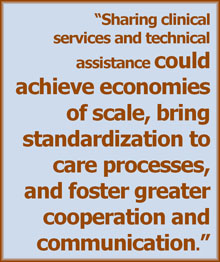Synopsis
To ensure that patients have a medical home, physician practices must meet a number of requirements, from round-the-clock access to care to a collaborative approach to managing chronic disease. Small practices lacking in resources and staff, however, face challenges in providing all medical home services in-house. By sharing technical and administrative support, outsourcing selected clinical services, and working together to improve quality and efficiency, practices can provide better care and become part of high performance health systems.
The Issue
 Patients with a medical home—that is, a primary source of care that ensures ease of access and communication, is efficiently coordinated, and engages in continuous quality improvement—are more likely to receive higher-quality care and experience fewer medical errors, all at lower cost. Providing this level of care to patients, however, is difficult for the small, nonaffiliated practices from which the majority of people get their care. Such practices are unlikely on their own to have the time or staff resources to provide 24/7 access to care, for example, or to provide comprehensive chronic disease management services. This article, authored by Commonwealth Fund staff members, shows how groups of small practices can band together to provide medical home services, sharing the costs and improving their performance. The authors present examples of shared resources, recommend ways to ensure their development and dissemination, and suggest organizational and structural changes.
Patients with a medical home—that is, a primary source of care that ensures ease of access and communication, is efficiently coordinated, and engages in continuous quality improvement—are more likely to receive higher-quality care and experience fewer medical errors, all at lower cost. Providing this level of care to patients, however, is difficult for the small, nonaffiliated practices from which the majority of people get their care. Such practices are unlikely on their own to have the time or staff resources to provide 24/7 access to care, for example, or to provide comprehensive chronic disease management services. This article, authored by Commonwealth Fund staff members, shows how groups of small practices can band together to provide medical home services, sharing the costs and improving their performance. The authors present examples of shared resources, recommend ways to ensure their development and dissemination, and suggest organizational and structural changes.
Key Findings
- After-hours care can be shared among practices. A children’s hospital in Denver, for example, coordinates urgent care by telephone for 91 percent of pediatricians in the area. When parents call their pediatricians between 5 p.m. and 8 a.m., the after-hours service is automatically notified, and a registered nurse calls the family to assess the situation.
- Care coordinators can support multiple primary care practices. Community Care of North Carolina provides case management, disease management, and care coordination services to Medicaid and Children’s Health Insurance Program patients, serving a base of 14 networks and 3,500 physicians in the state. The authors report that, since 2006, the program has saved the state $161 million annually.
- By using “extension centers,” practices can receive shared technical assistance. For instance, the New York City Primary Care Information Project helps physicians adopt electronic health records (EHRs) and provides assistance and training on using EHRs to improve patient outcomes.
- Shared resources should be established and organized locally. This allows primary care providers to meet and work directly with support service providers, which will help build familiarity and trust.
- A balance must be struck between providing needed services and allowing clinicians to maintain some degree of clinical autonomy. If clinicians believe that accepting assistance from an external organization will threaten revenues or independence, they are likely to forgo the assistance.
Policy Considerations
The federal health reform law contains provisions for testing the use of shared resources by primary care providers so they can meet medical home requirements. Toward this end, the Centers for Medicare and Medicaid Services, Health Resources and Services Administration, and Agency for Healthcare Research and Quality are all developing programs to promote shared resources for medical homes. The authors recommend coordinating these projects to ensure consistent selection criteria and performance measures, and deploying federal resources to help promote coordination among state-based pilots. Because rapid diffusion of best practices is essential, the U.S. Secretary of Health and Human Services should have the authority to modify, sustain, or expand pilot programs that prove successful.
The Bottom Line
Using shared resources could allow small, nonaffiliated practices to provide medical home services at a manageable cost. In doing so, they may also create a sense of shared accountability, improved quality of care for patients, and, ultimately, better health outcomes.